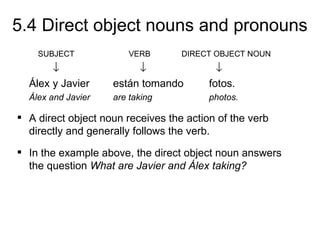
Directos objetos y pronombres
- 1. 5.4 Direct object nouns and pronouns SUBJECT VERB DIRECT OBJECT NOUN ↓ ↓ ↓ Álex y Javier están tomando fotos. Álex and Javier are taking photos. A direct object noun receives the action of the verb directly and generally follows the verb. In the example above, the direct object noun answers the question What are Javier and Álex taking?
- 2. 5.4 Direct object nouns and pronouns When a direct object noun in Spanish is a person or a pet, it is preceded by the word a. This is called the personal a; there is no English equivalent for this construction. Don Francisco visita a la señora Ramos. Don Francisco is visiting Mrs. Ramos. Don Francisco visita el Hotel Prado. Don Francisco is visiting the Hotel Prado. In the first sentence above, the personal a is required because the direct object is a person. In the second sentence, the personal a is not required because the direct object is a place, not a person.
- 3. 5.4 Direct object nouns and pronouns Direct object pronouns me me te you (fam.) SINGULAR lo you (m. form.); him; it (m.) la you (f. form.); her; it (f.) nos us os you (fam.) PLURAL los you (m. form.); them (m.) las you (f. form.); them (f.)
- 4. 5.4 Direct object nouns and pronouns Direct object pronouns are words that replace direct object nouns. Like English, Spanish sometimes uses a direct object pronoun to avoid repeating a noun already mentioned. DIRECT OBJECT DIRECT OBJECT PRONOUN Maribel hace las maletas. → Maribel las hace. Felipe compra el sombrero. → Felipe lo compra. Vicky tiene la llave. → Vicky la tiene.
- 5. 5.4 Direct object nouns and pronouns In affirmative sentences, direct object pronouns generally appear before the conjugated verb. In negative sentences, the pronoun is placed between the word no and the verb. Adela practica el tenis. Adela no tiene las llaves. Adela lo practica. Adela no las tiene. Carmen compra los pasajes. Diego no hace las maletas. Carmen los compra. Diego no las hace.
- 6. 5.4 Direct object nouns and pronouns When the verb is an infinitive construction, such as ir a + [infinitive], the direct object pronoun can be placed before the conjugated form or attached to the infinitive. Ellos van a escribir unas postales. Ellos las van a escribir. Ellos van a escribirlas. Lidia quiere ver una película. Lidia la quiere ver. Lidia quiere verla.
- 7. 5.4 Direct object nouns and pronouns When the verb is in the present progressive, the direct object pronoun can be placed before the conjugated form or attached to the present participle. Gerardo está leyendo la lección. Gerardo la está leyendo. Gerardo está leyéndola. Toni está mirando el partido. Toni lo está mirando. Toni está mirándolo.
- 8. 5.4 Direct object nouns and pronouns ¡ATENCIÓN! When a direct object pronoun is attached to the present participle, an accent mark is added to maintain the proper stress. To learn more about accents, see: Lección 4, Pronunciación, Lección 10, Ortografía, Lección 11, Ortografía.
- 9. 5.4 Direct object nouns and pronouns ¡INTÉNTALO! Choose the correct response to each question. 1. ¿Tienes el libro de español? a. Sí, la tengo. b. No, no los tengo. c. Sí, lo tengo. 2. ¿Me puedes llevar al partido de baloncesto? a. Sí, los puedo llevar. b. Sí, te puedo llevar. c. No, no las puedo llevar. 3. El artista quiere dibujarte con tu mamá, ¿no? a. Sí, quiere dibujarlos mañana. b. Sí, nos quiere dibujar mañana. c. Sí, quiere dibujarte mañana. 4. ¿Quién tiene las llaves de nuestra habitación? a. Yo no las tengo. b. Amalia los tiene, ¿no? c. Yo la tengo. 1 of 2
- 10. 5.4 Direct object nouns and pronouns Answer Key 1. ¿Tienes el libro de español? c. Sí, lo tengo. 2. ¿Me puedes llevar al partido de baloncesto? b. Sí, te puedo llevar. 3. El artista quiere dibujarte con tu mamá, ¿no? b. Sí, nos quiere dibujar mañana. 4. ¿Quién tiene las llaves de nuestra habitación? a. Yo no las tengo. 1 of 2
- 11. 5.4 Direct object nouns and pronouns ¡INTÉNTALO! Choose the correct response to each question. 5. ¿Quién te lleva al aeropuerto? a. Yo te llevo al aeropuerto. b. Rita los lleva al aeropuerto. c. Mónica me lleva al aeropuerto a las seis. 6. ¿Puedes oírme? a. Sí, te puedo oír bien. b. No, no los oigo. c. Sí, las oigo bien. 7. ¿Estudia ella los verbos irregulares? a. No, no la estudia. b. Sí, lo estudia. c. Sí, los estudia. 8. ¿Practican ellos la pronunciación todos los días? a. Sí, lo practican. b. Sí, la practican. c. No, no los practican. 2 of 2
- 12. 5.4 Direct object nouns and pronouns Answer Key 5. ¿Quién te lleva al aeropuerto? c. Mónica me lleva al aeropuerto a las seis. 6. ¿Puedes oírme? a. Sí, te puedo oír bien. 7. ¿Estudia ella los verbos irregulares? c. Sí, los estudia. 8. ¿Practican ellos la pronunciación todos los días? b. Sí, la practican. 2 of 2